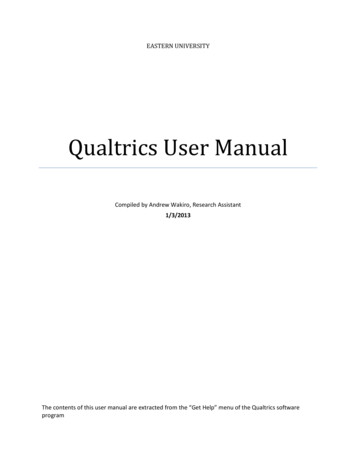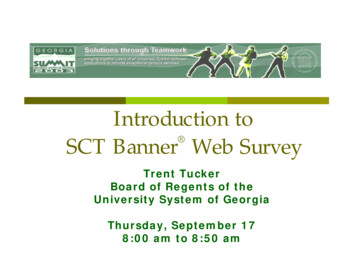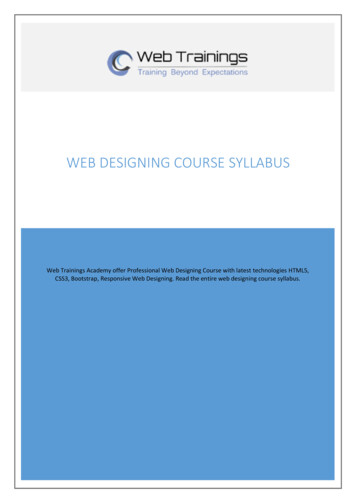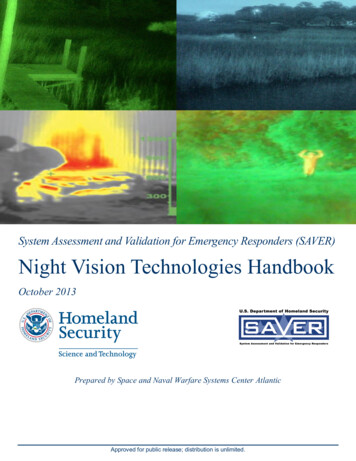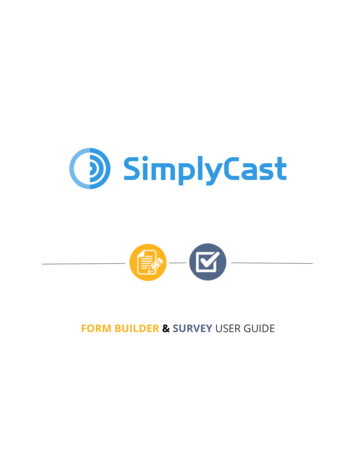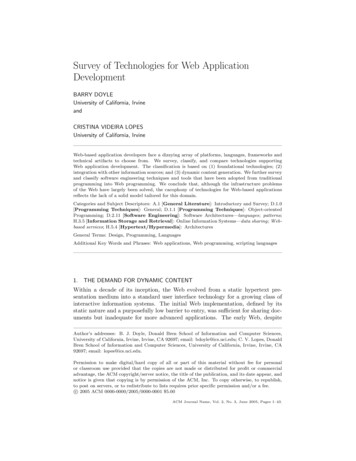
Transcription
Survey of Technologies for Web ApplicationDevelopmentBARRY DOYLEUniversity of California, IrvineandCRISTINA VIDEIRA LOPESUniversity of California, IrvineWeb-based application developers face a dizzying array of platforms, languages, frameworks andtechnical artifacts to choose from. We survey, classify, and compare technologies supportingWeb application development. The classification is based on (1) foundational technologies; (2)integration with other information sources; and (3) dynamic content generation. We further surveyand classify software engineering techniques and tools that have been adopted from traditionalprogramming into Web programming. We conclude that, although the infrastructure problemsof the Web have largely been solved, the cacophony of technologies for Web-based applicationsreflects the lack of a solid model tailored for this domain.Categories and Subject Descriptors: A.1 [General Literature]: Introductory and Survey; D.1.0[Programming Techniques]: General; D.1.1 [Programming Techniques]: Object-orientedProgramming; D.2.11 [Software Engineering]: Software Architectures—languages; patterns;H.3.5 [Information Storage and Retrieval]: Online Information Systems—data sharing; Webbased services; H.5.4 [Hypertext/Hypermedia]: ArchitecturesGeneral Terms: Design, Programming, LanguagesAdditional Key Words and Phrases: Web applications, Web programming, scripting languages1. THE DEMAND FOR DYNAMIC CONTENTWithin a decade of its inception, the Web evolved from a static hypertext presentation medium into a standard user interface technology for a growing class ofinteractive information systems. The initial Web implementation, defined by itsstatic nature and a purposefully low barrier to entry, was sufficient for sharing documents but inadequate for more advanced applications. The early Web, despiteAuthor’s addresses: B. J. Doyle, Donald Bren School of Information and Computer Sciences,University of California, Irvine, Irvine, CA 92697; email: bdoyle@ics.uci.edu; C. V. Lopes, DonaldBren School of Information and Computer Sciences, University of California, Irvine, Irvine, CA92697; email: lopes@ics.uci.edu.Permission to make digital/hard copy of all or part of this material without fee for personalor classroom use provided that the copies are not made or distributed for profit or commercialadvantage, the ACM copyright/server notice, the title of the publication, and its date appear, andnotice is given that copying is by permission of the ACM, Inc. To copy otherwise, to republish,to post on servers, or to redistribute to lists requires prior specific permission and/or a fee.c 2005 ACM 0000-0000/2005/0000-0001 5.00 ACM Journal Name, Vol. 2, No. 3, June 2005, Pages 1–43.
2·Barry J. Doyle and Cristina Videira Lopesits static limitations, demonstrated clearly enough the overwhelming potential andglobal reach of the new medium, setting in motion a rush of exploration into how tobring social, educational, and commercial applications online. Popular interest andmedia hype related to cyberspace, a science fiction turned plausible by the arrival ofthe Internet, raised expectations for the Web far beyond its humble origins to thoseof a universal hub of online information services [Bell 1997]. Up-to-date informationand effective user interfaces, essential requirements for online service applications,could not be practically implemented with only static content. Methods for providing dynamic content on-the-fly in response to user requests were developed to meetthe demands of Web service applications. Conceptually, dynamic content extendedthe early Web by providing an indirection level that allows users to request serverresources, programs that generate documents, as well as documents [Berners-Leeet al. 1998]. Powered by dynamic content generation systems, online commerce, education, and communication services became widespread, and the character of theWeb became increasingly application-centric rather than document-centric. At thesame time client-side interactivity was extended far beyond its original constraints,which limited interaction to only simple page-based navigation through hypertextlinks.1.1 The Static WebThe World Wide Web, commonly referred to as simply the Web, was developed in1990 at the European Organization for Nuclear Research (CERN) as a hypertextsystem for sharing documentation between disparate computers and applicationsover the Internet [Berners-Lee 1989; Berners-Lee et al. 1994; Berners-Lee andFischetti 2000]. The simple and open design of the Web attracted attention outsideof CERN, initially mainly within the network research community. Acceptanceof the Web accelerated after CERN released its implementation into the publicdomain in April 1993, which allowed organizations to experiment with the Webwithout concern for future licensing entanglements.NCSA Mosaic 1.0, the first Web browser with a graphical user interface (GUI),was released by the National Center for Supercomputer Applications (NCSA) at theUniversity of Illinois at Urbana-Champaign in September 1993. The NCSA Mosaicbrowser was simple to install and use on the X Windows, Microsoft Windows, andMacintosh platforms. The GUI browser was an immediate popular success that wasa catalyst for a rush of business interests and the public to embrace the Internet.The success of NCSA Mosaic and the Web lead to demands for dynamic content,improved interfaces, and connectivity to external systems. The age of purely staticWeb was effectively over when NCSA introduced the Common Gateway Interface(CGI) in late 1993 as a feature of the NCSA httpd 1.0 Web server. CGI allowsa browser client to request data from a program running on a Web server ratherthan from a static document. Other innovations such as browser fill-in forms andServer Side Includes (SSI) were additional early methods for making the Web moreinteractive and dynamic. Building on the early foundations provided by CERNand NCSA, the history of Web programming can be viewed as a continuing questfor improvements in efficiency, ease of use and reliability for interactive dynamiccontent generation.ACM Journal Name, Vol. 2, No. 3, June 2005.
Survey of Technologies for Dynamic Web DevelopmentFactor·3ObjectivesGlobal distributionInteractivityHuman and socio-economic factorsTable rtability over heterogeneityLoose couplingSecurityDynamic page generationData validationHandling of browser navigation anomaliesState managementEvent-actionAgile developmentDesigner/programmer integrationLearning effortPopularityConformance to standards and practicesWeb technology design factors.1.2 Web Technology Design PressuresThe Web architecture has evolved into an effective infrastructure for a wide classof complex, interactive services. Several factors shaped the mostly ad-hoc evolution of the Web. Table I summarizes the three major factors and some of theirpressures on the evolution of the Web. This table provides a set of criteria thatis used throughout the paper for assessing and comparing dynamic Web contentdevelopment technologies.Global Distribution. The Web is a distributed system that loosely couples clientswith geographically-dispersed servers through message-passing over the Internet.The HTTP protocol is a specific implementation of the general distributed systemsclient-server communications model. Web applications are implemented within adistributed application layer above HTTP, and are therefore bound to the requirements of distributed systems. Properties and design points for distributed operating systems that are important for the Web are reliability, extensibility, scalability,performance, heterogeneity, and security [Sinha 1997].Interactivity. Working around the user interface interactivity limitations of theWeb architecture is a central theme of Web programming. Constraints of theHTTP protocol, which impose a stateless, strictly pull-only architecture on Webapplications, mandate page-centered interactivity, limiting client processing to pagerendering, form data collection, and navigation to subsequent pages. Any interaction between a client and a server results in a complete page to be downloadedin response, even if the new page differs only slightly from the previous version.The level of interactivity is similar to the archaic block-mode interfaces that connect dumb terminals to mainframe computers. The need to address the limitationsof HTTP, which are justifiable for scalability and simplicity reasons, has providedmuch of the impetus for the development of technologies that have made the Webprogressively more reliable, interactive, and dynamic.ACM Journal Name, Vol. 2, No. 3, June 2005.
4·Barry J. Doyle and Cristina Videira LopesHuman Factors. Additional requirements for Web development technologies arerelated to human factors that reflect the cultural and social environment in whichthe applications are created.1.3 ObjectiveThe transition to the modern dynamic Web and beyond has generally been neitherorganized nor orderly, rather it was accomplished through independent innovationby many individuals and groups; sometimes collaboratively, sometimes competitively, and often in isolation. Web developers are pragmatic when evaluating newtechnologies: those that work well within the constraints of the applications areaccepted; others are ignored or become obsolete, not explicitly retired, but insteadgradually falling out of use. As a result, the Web development landscape is cluttered with a variety of technologies and tools, and littered with obsolete or failedoptions that can trap newcomers.The objective of this paper is to derive order from the chaos by describing thefoundations of the Web and classifying the related technologies and programmingtechniques that are used to create dynamic Web applications. Although server-sidedynamic content generation is an essential part of almost all Web applications,it is too enmeshed with other concerns to be adequately explored in isolation.Therefore, the remaining sections of this paper describe the relevant technologiesand techniques separately and as they evolved in relation to each another. In Section2, the Web’s architecture is reviewed, since it is the foundation for the technologiesthat support dynamic content. The progression of developments that made the Webincreasingly dynamic and reliable is reviewed to survey important technologies andthe context in which they were created. Section 3 surveys technologies specificallycreated for large enterprise software systems. A summary and classification of thetechnologies is presented in section 4, providing a roadmap for technology selection.Section 5 explores software engineering methods and tools that have been carriedforward from traditional programming into the realm of the Web, and assessestheir fitness and level of maturity for developing Web applications. Finally, section6 draws the conclusions of our study.2. SUPPORT FOR DYNAMIC CONTENTTechnologies are best understood in light of the context that motivated their creation. The evolution of the Web has been primarily motivated by a search forabstractions that improve its usability for end users, through richer user interfaces,and for developers with more powerful programming methods. This section recounts the road to dynamic content as a sequential narrative, starting with a briefreview of the architectural foundations of the Web and design points for Web applications. The remaining sub-sections describe the progression of developmentsthat shaped the dynamic Web, from the simple initial gateway methods that enabled dynamism, to the recent frameworks that aim to simplify development whileimproving reliability and functionality.2.1 An Architecture for Distributed Hypermedia ApplicationsThe architectural foundation of the Web is the request-response cycle realized bythe Hypertext Transfer Protocol (HTTP) [Fielding et al. 1999] and HypertextACM Journal Name, Vol. 2, No. 3, June 2005.
Survey of Technologies for Dynamic Web Development·5Fig. 1. A reference architecture for Web servers adapted from the architecture of Hassan and Holt[2000].Markup Language (HTML and XHTML) [Raggett 1999; Altheim and McCarron 2001] standards. The Representational State Transfer (REST) architecturalstyle provides a model architecture for the Web that was used to rationalize thedefinition of the HTTP 1.1 recommendation [Fielding and Taylor 2002]. Modularity, extensibility, and inversion of control are characteristics inherent in the Webthat have allowed incorporation of features supporting dynamic content. Inversionof control is implemented on both clients and servers by various plug-in, contenthandling, and filtering interfaces that allow custom components to be invoked inresponse to events. The following sections review the operations of Web servers andbrowsers highlighting the extension points that are leveraged to provide interactiveand dynamic content for Web applications.2.1.1 Web Servers. Web servers implement the server-side duties of HTTP, theapplication-layer protocol that governs message-passing between Web clients andservers. Figure 1 is adapted from a reference architecture for Web servers providedby Hassan and Holt [2000]. The most common Web server implementations arethe Apache HTTP server [Apache Software Foundation 2004], available for mostoperating systems, and the Internet Information Service (IIS) [Microsoft Corporation 2005b], available only for Microsoft Windows operating systems. Requestand response messages share a common format that includes a start line, messageheaders, and optionally, a message body and message trailers. Request messagesspecify a request method, most commonly GET or POST, and a Universal ResourceIdentifier (URI) for a requested resource. Resources as a key abstraction for theWeb, uniformly identifying documents, services, collections of other resources, andother types of information sources using a single naming scheme. Response messages include a status line and a resource representation of a resource. The protocolsupports transmission of any content type that can be represented as a sequence ofbytes with associated metadata. Responses are interpreted by client browsers.2.1.2 Web Browsers. Web browsers process user interface commands, formatand send request messages to Web servers, wait for and interpret server responsemessages, and render content within the browser’s display window area. Figure 2 isACM Journal Name, Vol. 2, No. 3, June 2005.
6·Barry J. Doyle and Cristina Videira Lopes! "!Fig. 2."##An architecure that illustrates the operations of Web browsers.a simplified architecture diagram that illustrates the operations of Web browsers.HTML and XHTML [Altheim and McCarron 2001] are the most common contenttypes on the Web. Browser extensibility features allow many other content types tobe displayed by deferring their rendering to registered plug-in components (helperapplications) that handle the content. The pervasiveness of HTML makes it afriendly target for dynamic content generation systems.2.1.3 HTML. HTML documents contain text interspersed with formatting elements. Cascading Style Sheets (CSS) allow formatting elements to be separated intoreusable style sheets [Bos et al. 2004]. Uneven CSS implementations in browsersand ingrained practices resulted in an extended acceptance period for style sheets.Promotion of Web standards and improved browser implementations of the standards have recently resulted in steadily increasing use of CSS to separate presentation attributes from content [Zeldman 2003].Client-side scripts can be embedded in HTML documents to add interactivity toWeb pages and further process a document before it is rendered by a browser. TheDocument Object Model (DOM) [W3C 2004a] interface allows embedded scriptsto modify the structure, content, and presentation of documents. The combinationof HTML, client-side scripting, and DOM is informally known as Dynamic HTML(DHTML). The most popular client-side scripting language is JavaScript. It isalso possible to reference Java applets, Flash presentations, and other kinds of precompiled programs within HTML documents, but the approach has compatibility,latency, and security issues that limit its effectiveness [Bellovin et al. 2000].2.1.4 XML. The Extensible Markup Language (XML) is a widely accepted markuplanguage that simplifies the transmission of structured data between applications[Yergeau et al. 2004]. XML is a meta-language for creating collections of customelements, in contrast to HTML, which provides a fixed set of elements. The Extensible Stylesheet Language (XSL) family includes a XML-based element matchinglanguage for XSL Transformations (XSLT) that is used to programmatically transform XML documents into other formats [Clark 1999].XML has been extremely successful standard since the original recommendationwas released in December, 1997. XML provides the base syntax for the XHTML andACM Journal Name, Vol. 2, No. 3, June 2005.
Survey of Technologies for Dynamic Web Development·7CSS standards that normalize and will eventually replace HTML as the dominantpresentation technology for the Web. Configurations for Web applications andservices are now commonly maintained within XML files. The extensive availabilityof XML parsers makes it more convenient for programmers to work with XML filesrather than develop parsers for proprietary file formats. Web services standardsincluding SOAP [W3C 2004b] and XML-RPC [Winer 1999] leverage XML forconfiguration and as a request and response message format for remote procedurecalls over HTTP.2.2 Initial DynamismThe earliest technical elements that allowed for interactive and dynamic contentwere HTML forms, the HTTP POST request method, and the Common GatewayInterface (CGI). HTML forms are used to collect user input data that is submittedto a forms processor on a Web server in a GET or POST message. By 1993, theavailability of CGI completed the forms processing path by providing a means bywhich Web servers could process and respond to submitted data. CGI is functionalbut not scalable; as its limitations became clear other solutions were developedthat were more efficient but more complicated. This section reviews the first waveof technologies for the dynamic Web including CGI, its server-side successors, andclient-side extension interfaces.2.2.1 Forms. The HTML forms capability naturally extends the Web’s document metaphor by allowing user input to be entered on Web pages. A form isa section of a document that contains named user interface controls such as textboxes, check boxes, radio buttons, list boxes, and buttons [Raggett et al. 1997].The definition of a form specifies a request method (GET or POST) and a URI for aserver-side forms processor. When a form is submitted, the browser formats a request message containing the form data as a sequence of name-value pairs. For GETmessages, the form data set is appended to the action URI as query parameters.When POST is used, the form data is sent in the message body.The forms capability of HTML is relied on by many Web applications. The formsinterface is simple, cross-platform, supports light data validation, and allows pagesto be event-driven. The event model of a form is implicit in the URI referencesassociated with submit buttons. The loosely coupled interaction between forms andtheir processors can be a source of reliability problems since there is no static guarantee that the data types of submitted data elements conform to the expectationsof form processor.2.2.2 CGI. CGI was the first widely available means for integrating Web serverswith external systems, initially provided as a method to process data submittedfrom HTML forms [NCSA 1993]. CGI allows server-side programs to be invokedin response to HTTP requests. A Web server creates a new process for each CGIrequest. Figure 3 shows the archictecture of CGI. CGI programs can be written inany programming language that supports environment variables and the standardinput and output streams. The earliest CGI programs were written in C, but thedeployment ease and portability of interpreted scripting languages such as tcl, Perl,and Python has made them the languages of choice for CGI [Ousterhout 1998]. Perlis the most popular language for CGI scripting. User input and metadata aboutACM Journal Name, Vol. 2, No. 3, June 2005.
8·Barry J. Doyle and Cristina Videira Lopes!!#!"Fig. 3.The CGI architecture.#! /usr/local/bin/perl# Display the form data set sent in a GET or POST request.print ”Content-type: text/html\n\n”;print ” html head title Form Data /title /head \n”;print ” body bgcolor \”#FFFFFF\”\n ”if ( ENV{’REQUEST METHOD’} eq ’POST’) {read (STDIN, buffer, ENV{’CONTENT LENGTH’});@pairs split(/&/, buffer);} elsif ( ENV{’REQUEST METHOD’} eq ’GET’) {@pairs split(/&/, ENV{’QUERY STRING’});} else {print ” p ENV{’REQUEST METHOD’} message received /p ”;}foreach pair (@pairs) {( name, value) split(/ /, pair); value tr/ / /; value s/%([a-fA-F0-9][a-fA-F0-9])/pack(”C”, hex( 1))/eg; name tr/ / /; name s/%([a-fA-F0-9][a-fA-F0-9])/pack(”C”, hex( 1))/eg;print ” p Field name has the value value /p \n”; FORM{ name} value;} print ” /body /html \n”;Fig. 4.An example of a Perl CGI script.requests is passed into CGI programs through environment variables and withinthe standard input stream, respectively. The output written by a CGI program toits standard output stream is sent to the client within an HTTP response message.The example Perl script in Figure 4 reads an environment variable to determinethe request method (GET or POST) and displays the data that was submitted froma form.CGI was the first widely supported technology for dynamic content and is stillsupported out-of-the-box by most Web servers. In tandem with scripting languages,ACM Journal Name, Vol. 2, No. 3, June 2005.
Survey of Technologies for Dynamic Web Development·9CGI is a platform-independent solution with a simple, well-known interface. Thedisadvantages are related to scalability and usability concerns. CGI is not highlyscalable because a new process must be created for each request. For busy Websites serving thousands of concurrent users, the CPU and memory usage requiredto constantly create and destroy processes severely limits the number of concurrentrequests that can be handled. The use of scripting languages further strains a Webserver’s capacity due to the need to start an interpreter for each request.The usability problems of CGI stem from the limitations of its thin abstractionover the HTTP protocol. Programmers must understand the workings of HTTP,down to the level of formatting details of resource identifiers and messages, tobe able to create CGI scripts. No page computation model is provided; the programmer is responsible for generation of the response by printing HTML to thestandard output stream. Role separation between designers and programmers isdiminished due to the fact that the presentation attributes of pages are embeddedwith print statements in programs. Web page authoring tools such as FrontPageor Dreamweaver can not be used since the presentation HTML is embedded withina program’s logic.Other responsibilities including state management, security, validation, data access, and event handling are completely delegated to programmers. A spate offragile, idiosyncratic Web application implementations were the result of the lackof structure allowed by CGI. The introduction of software engineering discipline inthe form of coding guidelines, scripting libraries, and frameworks has improved thesituation to some extent [Stein 1998].Despite its limitations, CGI is not obsolete. It natively exists within most Webservers, in contrast to other dynamic content solutions that require additional component installation. The out-of-the-box, universal availability of CGI makes it apossible target for small to medium-sized applications with low-volume expectations. Wu et al. [2000] found CGI to be inefficient in handling concurrent clientrequests and therefore suitable only for low-traffic applications based on benchmarkcomparisons to other options for generating dynamic content. The technology isstill in use mainly due to the increasing popularity of scripting languages, whichcan provide a straightforward, portable alternative to Java.2.2.3 Scalable CGI Implementations. FastCGI (Open Market), mod perl combined with the Apache::Registry module (Apache), and PerlEx (ActiveState) areexamples of Web server extensions that improve the scalability of CGI. FastCGIis a CGI implementation that maintains a pool of persistent processes that arereused for multiple requests to reduce process creation overhead [Brown 1996].Figure 3 shows the archictecture of scalable CGI implementations. mod perl isan Apache extension that embeds a Perl interpreter within the Web server thatallows Perl scripts to access the Apache C language API. Apache::Registry is aPerl library that supports CGI under mod perl. The combination of mod perland Apache::Registry improves performance by avoiding the overhead of startingand stopping a Perl interpreter for each request. An Apache Web server can alsobe extended to support corresponding capabilities for other scripting languagesincluding Python (mod snake, mod python), tcl (mod tcl), and Ruby (mod rubywith eRuby). PerlEx provides similar capabilities for Microsoft IIS by maintainingACM Journal Name, Vol. 2, No. 3, June 2005.
10·Barry J. Doyle and Cristina Videira Lopes!""!!"Fig. 5.!#"! !%"&"!'(The scalable CGI architecture.a pool of interpreters that is managed by a Web server extension module [ActiveState 2003].Gousios and Spinellis [2002] compared the performance of FastCGI, mod perl,and other technologies (PHP and Java servlets) on a Pentium III 733 MHz serverwith 384 MB of memory running Suse Linux 7.3. The conclusion was that FastCGIwas the best performing option for small sites without extensive integration requirements, while Java servlets were found to be more appropriate for large e-commercesites. Apte et al. [2003] compared the performance of CGI, FastCGI, Java servlets,and JSP and found FastCGI to be the best performing technology.2.2.4 Web Server Extension Interfaces. The initial reaction from Web serverproviders to CGI performance issues was to create proprietary APIs with similarcapabilities [Reilly 2000]. All of the major Web servers have APIs that can be usedto introduce new functionality into a Web server through extension modules. Themost well-known examples are NSAPI, originally created for Netscape Web servers[Sun Microsystems, Inc. 2003]; Microsoft ISAPI [Microsoft Corporation 2005a];and the Apache module API [Apache Software Foundation 2003]. Extension modules are usually required to be written in C or C and compiled into dynamiclink libraries that are linked into the Web server at runtime. Extensions can runextremely fast since they are compiled code that runs in the Web server addressspace.ISAPI and the Apache interface are representative of Web server APIs in general.ISAPI supports the development of extensions and filters that modify the behaviorof IIS. Figure 6 shows the placement of filters and extensions within the referencearchitecture. The corresponding Apache API constructs are modules, handlers,and filters [Thau 1996]. ISAPI extensions behave like CGI scripts; extensionsare invoked directly by clients or through URI mapping, and are responsible forhandling requests and creating responses. On IIS servers, a well-known exampleis the mapping of .asp files to asp.dll, the Active Server Pages interpreter. Acorresponding example for Apache is the association of .php files to the mod phpextension module. ISAPI filters perform additional behaviors in addition to thedefault behaviors, and can be used to implement custom logging, authentication,ACM Journal Name, Vol. 2, No. 3, June 2005.
Survey of Technologies for Dynamic Web Development·11"!Fig. 6.The reference architecture for Web servers modified to show filters and extensions.mapping, and retrieval features. The Apache API also filters as a modular way tomanipulate request or response data streams.Web server APIs were originally designed as scalable replacements for CGI, butthey are rarely directly used to build Web applications. The APIs are complex,non-portable, and require advanced programming knowledge, so extension modulesare difficult to build, test, and maintain. Reliability can be compromised due tothe tight integration of extensions into Web servers; a single flaw in an extensionmodule can crash a Web server. The cost of developing extensions is easier to justifyfor widely reusable features than for those supporting only a single application. Inspite of their weaknesses, Web server APIs are an important building block fordynamic content generation systems. In fact, for performance reasons most serverside technologies that support dynamic content are based on Web server extensionmodules.2.2.5 Browser Extension Interfaces. One of the first browser extension interfaces was the Common Client Interface (CCI) for NCSA Mosaic [NCSA 1995].CCI was an API that allowed external applications to communicate with runningbrowser instances by requesting a URL to be displayed. CCI is obsolete but influenced the browser extension technologies that followed.During the browser wars of the mid-1990s all of the major browser providers created proprietary APIs to differentiate their products. The Netscape Plug-In APIand Microsoft ActiveX are examples of browser-specific APIs. For systems requiring dynamic interfaces, the key features of browser-specific APIs are support forplug-in components and access to internal browser methods and properties relatedto the presentation of content. Security that prevents downloaded componentsfrom performing undesirable actions is a key requirement for brow
Survey of Technologies for Dynamic Web Development 5 supports transmission of any content type that can be represented as a sequence of bytes with associated metadata. Responses are interpreted by client browsers. 2.1.2 Fig. 1. A reference architecture for Web servers





